Wildfires have increasingly become a major threat to communities across the globe, and nowhere is this more evident than in the state of California. With massive wildfires fueled by drought, climate change, and high winds, the demand for aerial firefighting capabilities has never been more urgent. As wildfires surge, aerial firefighting companies are compelled to reassess their strategies, fleets, and collaboration with government agencies to effectively respond to these catastrophic fire outbreaks.
California boasts one of the largest fleets of aerial firefighting equipment in the world, maintained by the California Department of Forestry and Fire Protection, or Cal Fire. However, firefighting from the air is not solely the domain of state agencies; private companies play a crucial role in augmenting firefighting efforts when conventional resources are overwhelmed. Companies like 10 Tanker Air Carrier, utilizing converted DC-10 aircraft, are key players in these situations.
In a recent crisis, as wildfires raged through neighborhoods near Los Angeles, the immediate mobilization of air tankers and water bombers was imperative. These aircraft, designated as Very Large Air Tankers (VLATs), can drop thousands of gallons of fire retardant, making them an integral part of firefighting strategies. Such quick response systems highlight the pressing need for available resources during peak wildfire seasons and beyond.
Understanding the Financial Backing and Regulations
Despite the apparent urgency, aerial firefighting efforts often exist within a framework defined by seasonal contracts and financial limitations. The U.S. Forest Service, for instance, typically operates under fixed contracts that span specific months of the year. In 2023, the Forest Service began a significant 10-year contract with several aerial firefighting vendors, including 10 Tanker, potentially worth up to $7.2 billion. Yet outside of these contracted months, private companies opt for a call-when-needed approach, which can limit their operational readiness.
Compounding this issue is the traditional maintenance schedule of firefighting aircraft, which often coincides with the peak of fire seasons. Seasonal contracts can create operational lags, hampering several firms’ readiness to deploy resources when they are most urgently required. The unpredictability of climate and weather patterns makes it vital for these companies to remain agile and prepared for off-season emergencies.
The Challenges of Expansion and Fleet Modernization
As the frequency and severity of wildfires increase, the need for a larger, more advanced fleet becomes apparent. Companies like 10 Tanker are well aware that responding to this demand cannot happen overnight. The conversion of commercial aircraft to firefighting drones is an intricate process, often taking up to a year and a half. This extensive modification includes equipping the planes with the latest technology to assure precise and effective deployment of water and retardant.
Further complicating the expansion of firefighting capabilities are the recent trends toward environmental sustainability. As regulations tighten, companies must ensure that their aircraft meet stringent environmental standards. This has led to a shift from older models to modern aircraft designed with better fuel efficiency and lower emissions.
The effectiveness of aerial firefighting also significantly relies on the skilled pilots and crew involved in these operations. Many pilots come from military or commercial aviation, where they garner the expertise necessary to operate under high-pressure situations. The specialized demands of firefighting, however, add a unique challenge to their skill set.
The pilots undergo extensive training to maneuver large aircraft in windy and chaotic conditions while ensuring the correct delivery of retardants and water to precisely block fire paths. The variety of backgrounds among the crews also contributes to a rich tapestry of experience and knowledge that enhances operational effectiveness. However, the career itself is unconventional, and maintenance personnel must also be highly trained, ensuring each aircraft is in peak operational condition.
As the effects of climate change continue to contribute to a more volatile fire season, the importance of valuing aerial firefighting assets grows significantly. Companies must innovate and adapt, embracing new technology while addressing workforce challenges to ensure that firefighting resources are resilient and ready to respond at a moment’s notice. The urgent question remains: will our current systems and fleets be enough to meet the unprecedented demands of the 21st-century wildfire landscape? Only through cooperative efforts, funding reconsiderations, and innovative strategies can we hope to manage these growing threats effectively.

